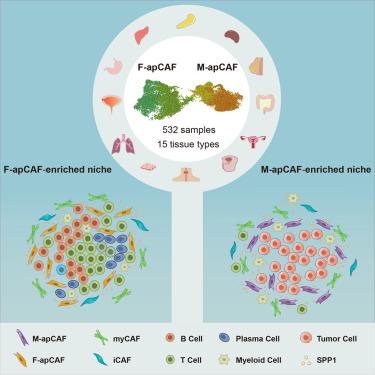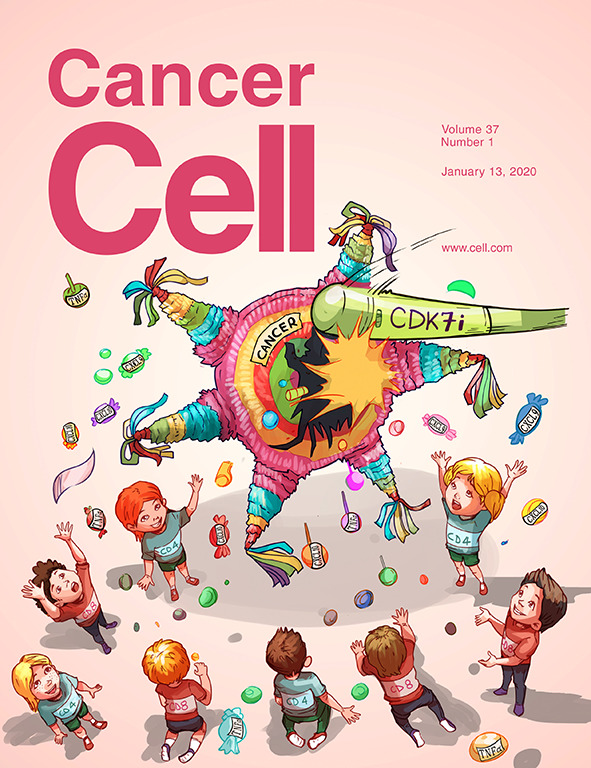抗原呈递癌相关成纤维细胞龛的单细胞分辨率空间分析
IF 44.5
1区 医学
Q1 CELL BIOLOGY
引用次数: 0
摘要
最近的研究发现了一种独特的癌症相关成纤维细胞(CAFs)亚型,称为抗原呈递CAFs (apCAFs),但对其知之甚少。为了全面了解apCAFs的起源和功能,我们构建了横跨15种组织和实体肿瘤的成纤维细胞分子图谱。我们的整合研究意外地揭示了两种不同的apCAF群体存在于大多数癌症类型中:一种与间皮样细胞相关,另一种与纤维细胞相关。利用高分辨率单细胞空间成像平台,我们描述了这些apCAF种群的空间生态位。我们发现间皮样apCAFs位于癌细胞附近,而纤维细胞样apCAFs与淋巴细胞富集的生态位相关。此外,我们发现这两个apCAF群体都可以上调分泌的磷酸化蛋白1 (SPP1),这促进了原发性肿瘤的形成、腹膜转移和治疗抵抗。综上所述,本研究为分析apCAFs及其空间生态位提供了前所未有的解决方案。本文章由计算机程序翻译,如有差异,请以英文原文为准。

Single-cell resolution spatial analysis of antigen-presenting cancer-associated fibroblast niches
Recent studies identify a unique subtype of cancer-associated fibroblasts (CAFs) termed antigen-presenting CAFs (apCAFs), which remain poorly understood. To gain a comprehensive understanding of the origin and function of apCAFs, we construct a fibroblast molecular atlas across 15 types of tissues and solid tumors. Our integration study unexpectedly reveals two distinct apCAF populations present in most cancer types: one associated with mesothelial-like cells and the other with fibrocytes. Using a high-resolution single-cell spatial imaging platform, we characterize the spatial niches of these apCAF populations. We find that mesothelial-like apCAFs are located near cancer cells, while fibrocyte-like apCAFs are associated with lymphocyte-enriched niches. Additionally, we discovered that both apCAF populations can up-regulate secreted phosphoprotein 1 (SPP1), which facilitates primary tumor formation, peritoneal metastasis, and therapy resistance. Taken together, this study offers an unprecedented resolution in analyzing apCAFs and their spatial niches.
求助全文
通过发布文献求助,成功后即可免费获取论文全文。
去求助
来源期刊

Cancer Cell
医学-肿瘤学
CiteScore
55.20
自引率
1.20%
发文量
179
审稿时长
4-8 weeks
期刊介绍:
Cancer Cell is a journal that focuses on promoting major advances in cancer research and oncology. The primary criteria for considering manuscripts are as follows:
Major advances: Manuscripts should provide significant advancements in answering important questions related to naturally occurring cancers.
Translational research: The journal welcomes translational research, which involves the application of basic scientific findings to human health and clinical practice.
Clinical investigations: Cancer Cell is interested in publishing clinical investigations that contribute to establishing new paradigms in the treatment, diagnosis, or prevention of cancers.
Insights into cancer biology: The journal values clinical investigations that provide important insights into cancer biology beyond what has been revealed by preclinical studies.
Mechanism-based proof-of-principle studies: Cancer Cell encourages the publication of mechanism-based proof-of-principle clinical studies, which demonstrate the feasibility of a specific therapeutic approach or diagnostic test.
 求助内容:
求助内容: 应助结果提醒方式:
应助结果提醒方式:


